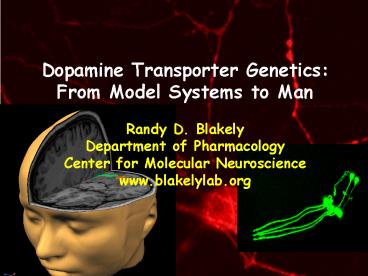Dopamine Transporter Genetics: - PowerPoint PPT Presentation
1 / 36
Title: Dopamine Transporter Genetics:
1
Dopamine Transporter Genetics From Model Systems
to Man Randy D. Blakely Department of
Pharmacology Center for Molecular
Neuroscience www.blakelylab.org
2
Regulated Trafficking of Biogenic Amine
Transporters
S
P
P
Syn 1A, PP2Ac dissociate
P
Phosphorylation
R
e
c
y
c
l
i
n
g
R
P
P
Internalization
3
Studying Transporters in C. elegans
Why use a worm model? small size (1mm)
numerous progeny, self-fertilization ease of
laboratory cultivation anatomically
simple (1) 959 somatic cells (2) 302-cell
nervous system transparent all synaptic
connections identified completed genome
sequence methods for generating gene KOs
are well-developed methods for generating
trangenic animals are well-developed
4
Dopaminergic Neurotransmissionin C. elegans
Anatomy
Function
Mechanosensation Egg-laying Locomotion Pharyngeal
pumping Mating (male)
Genes
DA Histofluorescence
CAT-1 Tyrosine Hydroxylase CAT-2 VMAT CAT-4 GTP
Cyclohydrolase BAS-1 AADC DAT-1 DA Transporter
Courtesy, J. Duerr
5
(No Transcript)
6
(No Transcript)
7
Imaging DAergic Neurons in Living Animals
Head
Head
ab
ADE
terminal bulb
NR
metacorpus
NR
cb
CEP
Tail
Tail
PDE
vulva
pb
8
(No Transcript)
9
a
d
2 µm
b
e
c
f
10
Expression of TAP-Tagged DAT-1 for Purification
of Associated Proteins
11
Affinity Purification of DAT-1Associated Proteins
12
Transporters Support the Accumulation of
Neurotoxins
13
6-OHDA Treatment Results in the Loss of
CeDATGFP Expression
Nass et. al., PNAS, 2002
Control
6-OHDA
6-OHDA/Imipramine
6-OHDA/Amphetamine
14
dat-1 KO in C. elegans
PCR primers for
deletion analysis
N2
dat-1(0)
500 bp
Region of deletion in dat-1 (0) Loss of exons 4-12
dat-1 Deletion
Single Worm PCR
15
DAT-1 KO Blocks 6-OHDA Toxicity
wt/PDAT-1GFP (6-OHDA)
wt/PDAT-1GFP
dat-1/PDAT-1GFP
dat-1/PDAT-1GFP (6-OHDA)
16
Genetic Screen for Genes SupportingToxin-Induced
DA Neuron Death
Discard
Treat with DA Neuron Toxin
Keep!!! DAT Mutants Regulation Mutants Toxicity
Mutants
Mutagenize
17
Lines Harvested from EMS Screenfor 6-OHDA
Resistance
Normal CEPs ( worms)
Line Designation
18
6-OHDA Screen Yields Both DAT and Non-DAT
Suppressors of Toxicity
DAT Suppressor
Normal CEPs ( worms)
6-OHDA Resistant
Wildtype (BY-200)
Non-DAT Suppresor
Line Designation
19
Identification of DAT-1 Mutants Supporting 6-OHDA
Resistance
Mutant 25 G55E (G75E)
Mutants 13, 62 G90E (G110E)
20
Transport Analysis of DAT-1 Mutations50nM 3H
Dopamine
21
Immunoblot Analyses of HA-Tagged DAT-1 and
Mutants in COS-7 Cells
TTotal, SSurface (Biotinylated)
DAT-1 DAT-1 pcDNA3 DAT-1
G55E G90E
DAT-1 pcDNA3 DAT-1
?K584R
M.W. (KDa)
M.W. (KDa)
108-
97--
90-
48 --
50.7-
T
S
T
S
T
S
T
S
T
S
T
S
T
S
22
Summary
C. elegans DA neurons are sensitive to acute
application of 6-OHDA in a dat-1 dependent manner.
Forward genetic strategies can be used to
identify molecular determinants of 6-OHDA-induced
neurodegeneration.
The most frequently recovered suppressors are in
dat-1, the C. elegans DA transporter and alter
the coding sequence. These mutations reduce DA
transport activity in transfected cells.
Mutations recovered reveal critical contributions
of conserved residues in DAT-1 TM1 and 2 and the
C-terminus for transporter biosynthesis and
trafficking. Preliminary studies
indicate decreased localization of dat-1 mutants
to nerve ring and processes.
Non-dat-1 genes participate in dat-1 function,
dat-1 regulation or in the sensitivity to
neurotoxin.
23
Human Diseases Supported by Catecholamine
Transporter Dysfunction? Issues of Functional
Compensation? Can Phenotypes of Rare
Transporter Variants Illuminate Convergent
Pathways Supporting Brain/Behavioral Disorders?
24
Monoamine Transporter Gene Organization
NET
16q12.2
DAT
5p15.3
SERT
17q11.1-12
25
Orthostatic Intolerance Symptoms
- Lightheadedness, palpitations, pre-syncope, and
dizziness. (80 of patients) - Syncope (56 of patients)
- Fatigue (44 of patients)
- Symptoms consistent with decreased cerebral
perfusion.
26
A Mutation in the Human Norepinephrine Transporter
GCC
CCC
DNA
Alanine
Proline
Protein
27
Inheritance of A457P Mutation in Three
Generations of a Family
Male
Female
28
A457P Tracks with Elevated Heart Rate
29
Keeping the Periphery in Mind
OI
heart rate DHPGNE tyramine
Anxiety
Depression
ADHD
30
ADHD Pharmacology Methylphenidate DAT
Blocker Increases extracellular DA/NE by blocking
catecholamine reuptake (DAT and
NET) D-Amphetamine DA/NE Releaser Increases
extracellular DA by triggering transporter (DAT
and NET) reversal Atomoxetine (Strattera) NET
Blocker Increases extracellular DA/NE via
reuptake blockade (nonstimulant)
31
Hypothesis ADHD may represent a clinical
phenotype enriched for functional DA transporter
coding variants Study of individuals and
families with DAT coding variants may clarify
role of central DA systems in facets of ADHD
32
Automated SNP Discovery via TGCE
33
SNP Detection via TGCE
242 C/C - Control
Wild-type sequence
242 C/T - A028-ADHD
Heterozygous SNP
242 T/T - A027-ADHD
Homozygous SNP
34
SNP Analysis in ADHD Subjects
ADHD Subjects Recruited Combined ADHD 40/46 -
87 Male 40/46 - 87
Hyperactive/Impulsive 6/46 - 13
Female 6/46 - 13
35
Nonsynonymous SNP Identified in hDAT Exon 13
A559V
Future Directions
- Pedigree genotype/phenotype assessment
- Physiology and regulation vs reference seq
- Additional subject screening
- Extension of effort to bipolar disorder
TMD 11
TMD 12
36
Acknowledgements C.elegans H. Sapiens
Francesca Binda Steve Couch Lucia
Carvelli Maureen Hahn Tammy Jessen Denise
Malone Paul McDonald Michelle Mazei
Richard Nass Angela Steele Lou
DeFelice, Aurelio Galli NIDA, NHLBI,
NIDDK, NIMH

